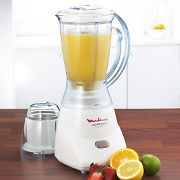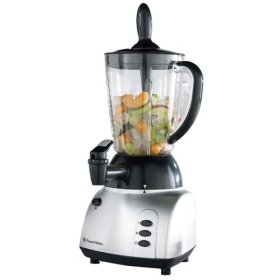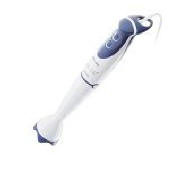|
BASE
In order to make the mixture more drinkable and less pulpy, additional liquid or
soft substances are usually used as a base such as:-
Fruit Juice
Coconut Milk
Water
Milk
Soy or Rice Milk
Yoghurt
Ice Cream (See also "Cold (frozen items)"
Sorbets (See also "Cold (frozen items)"
The last 3 items have the added advantage of creating a smoother thicker texture
after blending, much like a milkshake, with ice cream and sorbets doubling up as
the "frozen" element.
You can use any flavour of yoghurt, ice cream, sorbets or milk depending on the
recipe and your personal taste, and full or low fat products. The only
restrictions are those you set for yourself. Just remember, smoothies are not
only made for nutritional purposes, they are also to be enjoyed: unless you have
specific medical problems, it�s better to have a few extra calories in the form
of sweetener or dairy products along with the fruit, than no fruit at all
because it's too sharp.
Â
FROZEN
In order to get the right thickness
and texture a frozen element is generally required. This can be added in
various forms:-
Â
Ice Often crushed or
cracked ice cubes are used however these can sometimes lessen the flavour so
using flavoured frozen cubes is a good alternative. See below under
�preparation� for detailed information.Â
Â
Frozen fruit retains its
vitamins and, unlike in other recipes, the softening of tissues and subsequent
loss of structure of fruit such as strawberries doesn�t detract from the
finished article so it is just as good to use them. Also, the ice content in the
fruit acts as a thickener once blended making the addition of extra ice
unnecessary.
Â
Although you can buy frozen fruit,
quite often these have added sugar or syrup so why not freeze your own. The
benefits of this include:-
(a) freezing one-portion amounts for ease and speed of use
(b) only adding as much sugar or other sweetener as you want
(c) taking advantage of low shop prices when the fruit is in season
Â
Ice Cream /Sorbets
Any type of ice cream or sorbet can be used - full fat or low fat, single or
duplex flavoured, smooth or containing ripples, nuts or other additions.
Â
Other ingredients
Sweeteners such as honey, sugar or maple syrup can be added to enhance
the overall flavour, especially when the fruit used isn�t sweet � unfortunately
a common occurrence with the forcing of so many fruit today.
Flavourings. Don�t be afraid to experiment with flavourings such as
cinnamon, nutmeg or other sweet spices.
Seasonings. When using vegetables, a more savoury result can be obtained
by using seasonings such as pepper, salt, chilli, pepper sauce garlic salt etc.
Alcohol. Adult smoothies can be made with the addition of small amounts
of alcohol � think Bloody Mary � tomatoes, vodka, Worcestershire sauce �.
preferably not for breakfast. A novel idea is to make small �shot glass�
portions as an appetiser before dinner.
Textured smoothies can be made with added ingredients such as oats,
muesli, wheat germ, bran, flax seeds, honey, wheatgrass powder or other nutrient
mixes to give an extra boost, especially for breakfast. Ground nuts or
peanut butter can also be used for extra protein and flavour.
Â
Smoothie Preparation
Fruit and Vegetables
Always wash fruit or vegetables before using. To avoid lumpy bits in your
smoothie, fruit or vegetables should be cut up into manageable pieces. Pay
particular attention to hard ingredients such as apples and carrots and if using
these in conjunction with softer ingredients, cut them up slightly smaller and
put them in the blender first, adding the softer items shortly afterwards. It
doesn�t take too much more time, perhaps a few seconds, but it can make a
significant difference to the overall finished texture.
The question of whether to peel or remove seeds is answered very simply. If you
would normally eat the skin or seeds then add them to the smoothie. So, for
example, most of us wouldn�t eat the skin of a kiwifruit or the seeds of an
orange but we would eat the skin of an apple and the seeds of a passion fruit.
Base
Where possible, chill the base liquid before using in smoothies. If you're
not sure how thick you like your smoothie, don't add all the recommended base.
You can always add more at the end and give it a final short whiz to
incorporate.
Ice
Never add whole ice cubes, especially when using a normal household blender.
Either crack or crush ice before adding to the blender. A quick way of cracking
ice cubes is to put them in a plastic food bag, place on a solid surface and
bash with a mallet, hammer or wooden rolling pin.Â
Â
A good alternative to plain ice is
to freeze quantities of base liquids in ice cube trays in advance, which
will not only remove the need to use crushed ice, but will also return a truer
flavour in the finished smoothie. Fruit juices, milk and coconut milk can all be
treated in this way. Simply substitute the required amount of ice with the same
amount of frozen base.
Â
Â
Making and drinking your
smoothie
Â
Once you�ve prepared the ingredients
as above, place the base (liquid, ice cream etc ) into your blender then add the
fruit or vegetables (remember harder items first if using) and pulse blend a few
times.
Once it�s broken down a little, add the ice and start blending on a low speed,
increasing to high until smooth. The whole blending process should only take
less than a minute in most instances.
There are no hard and fast rules when it comes to the thickness of smoothies:
it�s all down to personal preference. If the mixture seems too thick, add more
of the base ingredient or even a little water. Alternatively, if it seems too
thin, either add more fruit or ice which will thicken it up once re-blended.
It�s best to drink the smoothie straight away for maximum health benefits.
However, if you have made too much, you can freeze what�s left, but make sure
you leave headspace in the container as the mixture will expand a little during
the freezing process. Frozen smoothies should be removed from the freezer about
an hour before drinking.
Back to top
 |



